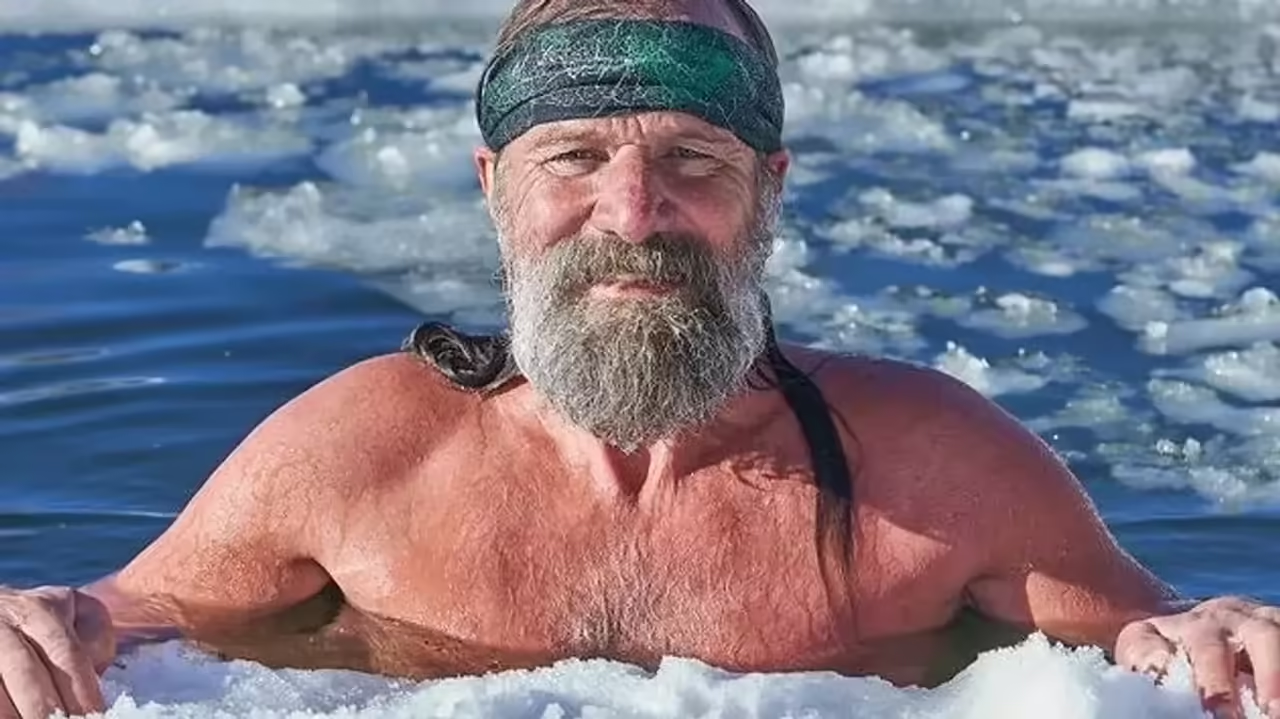
Many people are unable to put a fingernail in water that is less than 20 degrees, so they see in this character a superman. Wim Hof, known as “the ice man”, is the record holder for being covered in ice, with nothing more and nothing less than 1 hour and 42 minutes buried in ice cubes.
The guy has spent the last 20 years training in extreme weather conditions to beat this record, which can not be said to be of much use, but well, in these things of self-improvement you know that the limits are set by oneself. And how did you train to become a penguin man?
Well, easy; you just have to buy some shorts and go running through snowy peaks, barefoot, of course, and if you pass near a frozen lake make a hole and take a good dip. Thus, day after day, you end up, whether you like it or not, becoming immune to these polar temperatures.
Good old Hof, a Dutchman by birth, realized one day after taking a dip in the waters of a small lake in a park, that he had a certain innate ability to withstand the cold and that he also felt a certain gustirrinín in it. From that moment on it was non-stop and at home the hot water was only used to boil potatoes.
In 2000, dressed only in a bathing suit, he dived under the ice at the North Pole and won a Guinness World Record for the longest time swimming under the ice.
Braving temperatures of minus three degrees in the water, the temperature dropped to a low of minus 30 degrees when he emerged from the water.
“The first big challenge was to swim a distance of 60 meters under ice covered one meter thick beyond the Polar Circle,” he recalls.
“My goggles froze and I lost sight of the start and that’s probably why I broke the record.” -. Around 80 m.
For the Iceman, Wim Hof, who also holds the record for the longest time spent in a pool full of ice cubes (1h 42m 22s), one of the solutions to avoid this problem is for people to expose themselves more to the cold: “Since everyone is already covered with jackets and coats, the skin is not trained to withstand low temperatures.” The method to become cold-resistant according to Hof is as follows: start by taking short showers of cold water, thus training the veins to close so that the internal temperature remains at a good level.
The summer the Twin Towers fell was especially hot. I would go to the gym and stay for up to 30 minutes in the ice water pool, with my whole body submerged up to my nose. I looked like a hippopotamus or crocodile, almost without movement. I studied people’s reactions when they entered the pool: many already felt the cold before even touching the water. I understood that apart from training the skin, it is also very important to overcome the cold in the head.
Taking cold showers is an old practice advised to calm down – if I remember correctly, even Jung wrote in his memoirs that he practiced it from time to time. And it is true: as time passes in the pool the mind clears and after 7 or 8 minutes it is possible to hear the heartbeat. The experiment lasts until my body starts to shiver with cold: then I get out.
Wim Hof says that a temperature of minus 17 degrees Celsius is not cold:
“I call it refreshing. When I walked a half marathon in the Arctic Circle in bare feet at minus 30 degrees I did feel cold.”
The benefits of the Wim Hof technique: exploring the science behind breathing and cold exposure
The Wim Hof technique is based on a series of breathing exercises that are designed to control the body’s response to stress. The goal is to lower the heart rate and increase the concentration of oxygen in the body. Hof breathing exercises are designed to make the body alkaline, which means it becomes less acidic. An alkaline body can better fight inflammation, which can be beneficial for those suffering from autoimmune diseases and other health problems.
Aside from breathing exercises, the Wim Hof technique also includes cold exposure. Cold exposure is believed to have a number of health benefits, including reducing inflammation and increasing white blood cell production in the body. Cold exposure has also been linked to an increased sense of well-being and improved sleep quality.
The science behind the Wim Hof technique has been the subject of a number of scientific studies. A 2014 study found that subjects who practiced the Wim Hof technique had an increased immune response after exposure to endotoxin, a bacterial toxin that induces an inflammatory response. Subjects who practiced the technique also reported a significant reduction in inflammation symptoms.
Another 2018 study found that subjects who practiced the Wim Hof technique had increased sympathetic nervous system activation and a lower level of cortisol, the stress hormone. The study authors concluded that the Wim Hof technique may have beneficial effects on the autonomic nervous system.
The Wim Hof technique has also been linked to improved symptoms of depression and anxiety. A 2016 study found that subjects who practiced the Wim Hof technique for eight weeks reported a significant reduction in symptoms of depression and anxiety compared to the control group.
Overall, the Wim Hof technique can be an effective way to improve health and well-being. The combination of breathing exercises and cold exposure appears to have significant benefits for the immune system, autonomic nervous system and mental health. If you are interested in trying the Wim Hof technique, it is important to do so with caution and under the supervision of a trained health professional. With a little practice and patience, the Wim Hof technique can be a useful tool for improving your health and well-being.
It is important to keep in mind that the Wim Hof technique is not a panacea for all health problems. If you have chronic health problems or are taking medications, it is important to talk to your doctor before beginning any exercise program or lifestyle changes.
Also, while the Wim Hof technique may be effective for some people, it is not suitable for everyone. Some people may have an increased sensitivity to cold or may have breathing problems that make it difficult to practice the breathing exercises.
Wim Hof’s extreme challenges: from climbing Everest in shorts to immersing yourself in freezing water for hours
Mount Everest is one of the greatest challenges a human being can face. With a height of over 8,000 meters, it is an inhospitable and dangerous place. However, Wim Hof decided that it was not enough to simply climb to the top of Everest. In 2007, Hof completed a partial ascent of the mountain in shorts and without shoes, making him the first person to accomplish such a thing. Although the feat was not complete, it is still an impressive feat.
Another extreme challenge Wim Hof has accomplished is immersing himself in freezing water for hours at a time. In 2009, Hof set a world record by staying submerged in ice water for 1 hour and 44 minutes. In 2011, Hof broke his own record by remaining submerged for 1 hour and 52 minutes. During this time, his body temperature dropped significantly, but he managed to recover quickly after coming out of the water.
So how is Wim Hof able to overcome these extreme challenges? The answer may lie in his breathing technique and exposure to cold. Hof has developed a controlled breathing technique that focuses on increasing the concentration of oxygen in the body. He has also developed an ability to control his autonomic nervous system, which allows him to better withstand the cold.
The science behind Wim Hof’s technique suggests that controlled breathing can have significant effects on the immune system, autonomic nervous system and mental health. Exposure to cold has also been linked to a number of health benefits, including reduced inflammation and increased production of white blood cells in the body.
However, it is important to note that the extreme challenges of Wim Hof are not something that should be attempted without proper preparation. The human body is not designed to withstand extremely cold temperatures or extreme altitudes, and doing so without proper preparation can be dangerous.
How to get started with the Wim Hof technique: practical tips for those who want to explore breathing and the extreme cold
Do your research: Before you start, it is important that you know what you are doing and understand the principles behind the technique. Wim Hof’s official website is a good place to start, as it offers detailed information about the technique, instructional videos and online courses.
Start with the breath: Wim Hof’s breathing is the first step in the practice. It is a rhythmic breathing technique that involves breathing in deeply and exhaling fully in cycles. You can start by practicing the breath at home, and you can find many tutorials online that will guide you through the process. It is important to make sure you are in a safe and quiet place while you do it.
Adjust your breathing technique: The Wim Hof breathing technique can be very intense, especially in the beginning. If you feel uncomfortable or dizzy, you may need to adjust the technique to better suit your body. Don’t worry if this happens, it is completely normal. Take your time and experiment with different breathing rhythms and depths until you find what works best for you.
Introduce cold: Once you feel comfortable with the breath, it’s time to introduce cold into your practice. You can start with a cold shower or soaking your feet in cold water for a few minutes a day. Over time, you can increase the duration and intensity of cold exposure.
Be consistent: As with any practice, consistency is key. If you want to experience the benefits of the Wim Hof technique, it is important that you do the breathing and cold exposure on a regular basis. Try to incorporate the practice into your daily routine and set a schedule that works for you.
Be aware of your limits: It is important to remember that the Wim Hof technique can be intense, and it is not for everyone. If at any time you feel uncomfortable or experience troubling symptoms, stop the practice and consult a health professional.







